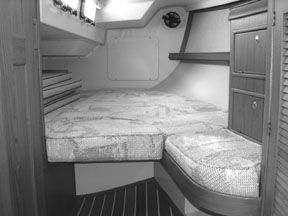
When it comes to choosing cushions for your boat, David Ogle, president of Handcraft Mattress in Irvine, CA offers an important reminder: “Ashore or afloat, one-third of your life is spent in bed. And you probably need good rest on a boat more than at home,” he added. “Boats are great, but they can be tiring.” That’s why a good sleeping surface is important; and in addition, as one wag put it: “A man needs a good workbench.”
The mattress you sleep on no longer must be rock hard to be considered healthy. The British medical Journal, The Lancet, reported last May that a study had proved that a hard mattress is no better for healthful sleeping than a soft mattress. The hard-mattress experts reigned for years, but now they’re akin to the eight-glasses-of-water proponents (recently discredited), or the ones who said fresh fruits and vegetables are more nutritious than canned versions (turns out it ain’t so).
Whether you call them bunk cushions, berth cushions, or just plain mattresses, how do you pick something good to sleep on for your boat?
“There’s a lot of crap out there,” asserted Paul DiMartino, owner of S&S Fabric in Portsmouth, RI, a company that designs and fabricates cushions for sailboat berths, settees, and cockpits. “A buyer should take a little time to sort it out.”
A Bit of History
The mattress business is a huge industry. That’s because a mattress is a fairly expensive, used-by-everybody item that must be replaced often. And in the B.F. era—before foam—mattresses were terrible. They were made mostly of cotton fluff, junk material, sometimes even kapok, which is a mass of silky fibers from Malasia’s ceiba tree. Kapok is the same stuff once used to stuff cheap (but USCG-approved) life preservers. The kapok was sealed in clear plastic bags; if the bag was punctured, there went the ball game.
Under these soggy mattresses were metal springs—an open metal framework to which were wired or clipped coil springs, or sets of flat metal strips with little springs on each end. To this day, despite modern powder coating and plating, the springs wear and rust. (Mattresses on board boats tend to get moist.)
No matter what materials were used, even expensive mattresses dressed up with puffy, brocaded covers started to sag on night No. 1. The remedy was to flip them, rotate them, sun them, beat them. (Because of their non-symmetrical shapes, very few boat mattresses can be turned.) Afloat or ashore, a mattress, especially if used by a heavy individual, didn’t last long.
All the miserable early mattresses—whether straw-stuffed blue cotton ticking, feather beds, or horse hair mattresses—have virtually disappeared, only to be replaced, at the low end, by thin, poor-quality foam rubber mattresses that deteriorate very quickly.
Luckily, as foam rubber technology expanded, it forced improvements in regular mattresses, which generally are called “inner-spring” mattresses because springs are embedded not only in the box springs, but in the mattresses themselves. The elasticity in a modern inner-spring mattress is provided largely by coil springs. The standard spring is 3″ in diameter, tied in place and covered with padding, which usually includes some foam rubber.
Dual-Purpose Quandary
One of the enduring problems with mattresses is that something to sit on is not something you want to sleep on. It’s not often taken into consideration that when you sit on a cushion, most of your weight is concentrated on a one-square-foot area. The cushion needs to be firm. If you try to sleep on a mattress made like that cushion, your body will probably find it too hard because your weight will be spread over an area five or six times larger. Conversely, a cushion soft enough for pleasant dreams will “bottom out” when sat upon.
“That’s why,” said Greg Palmer, a third-generation marine mattress maker in Philadelphia, “we suggest innersprings for V-berths and quarter berths. They are for sleeping. But because innerspring mattresses don’t like to be sat upon, you use cushions of good latex foam for the main cabin.”
That combination is not often seen in production boats, which usually have cheaper, foam bunk cushions throughout. And for serious race boats, thin foam mattresses are lighter than innerspring mattresses.
One other, fairly new product has entered the mattress arena. Several decades ago, the National Aeronautical and Space Administration (NASA) spent a heap of our money to develop a cushioning that would not only protect astronauts from G-forces, but also give them a good resting and sleeping surface. What NASA came up with is called viscoelastic polyurethane. Generally, it’s referred to as “memory foam,” which is essentially a very high density, open-cell foam.
Fagerdala Foams, a Swedish company, worked another eight years to improve on NASA’s foam by layering it and providing a good cover to control mites, bacteria, mold, and mildew. Although other companies now make “memory foam,” Fagerdala’s Tempur-Pedic claims its proprietary manufacturing process offers the precision required for good foam. Its marine mattresses are made and sold by an allied but separate company called Tempur-Marine.
Big shops—like California’s Handcraft—have representatives scattered around the country to visit boats and take measurements. Some shops have measurement kits complete with instructions. (Because of modifications, even within stock boat production runs, it isn’t practical for mattress makers to keep patterns.) If you passed geometry in high school, you’ll have no trouble with the measurements. Just take it one mattress at a time; on most boats, no two are alike.
The Current War
There are hundreds of little canvas shops around the country that make mattresses for boats, but those named in this report seem to be the leaders. And it seems that boat owners have two basic choices between fiercely competing marine mattress makers. (Not in the running: Air mattresses, which are rock hard; and water beds, which are too heavy for boats.) One is a combination of innerspring bunk cushions (for the V-berths and quarterberths) and good foam cushions for the saloon. It’s important to keep in mind that with foam, the higher the density, the better the quality. Light foam breaks down quickly. High-density foam is expensive, but important for both comfort and long service.
The other choice is plain foam, andthere are hundreds of kinds available. The aforementioned memory foam is one. Dave Ogle, of the previously mentioned Handcraft Mattress, said that Tempur-Pedic’s memory foam gets hard in cool temperatures and that it tends to mold and pick up bacteria. (Handcraft, whose mattresses are unique in that they can be folded in half for easy handling, has 35 employees, is the biggest marine mattress maker, claims to have about 90% of the boat mattress business, turns out up to 150 mattresses a week, and is an OEM supplier to many boat builders.)
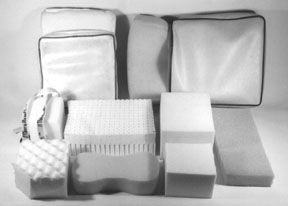
PS promptly put a piece of Tempur-Marine’s foam in the refrigerator and, sure enough, it got very hard. However, when a hand was placed on the surface, it immediately began softening. (See photo and caption on pg. 6 for a more reasonable experiment.)
Andy Flack of NautiPedic caters to the mega-yacht trade with an innerspring mattress that features 1,100 two-inch springs (in the king-size version) rather than industry-standard three-inch springs. “Sleeping on a boat ought to be preferred to sleeping on land,” Flack said, “so we make the very best mattress we can….about 300 to 500 of them a year.”
Dale Humbert, a 57-year-old retired Dow plastics chemist who five years ago started Tempur-Marine to keep busy, has five regular employees in his Saginaw, MI, shop. Now a “memory foam” expert, he said the distinction between closed-cell foam and open-cell foam has become very blurred.
“There’s a tremendous difference in various foams,” he said, “and the trick when making a mattress is to make it dissipate vapor and avoid heat buildup. It’s best done with a dense foam that, through capillary action, provides circulation. Cheap memory foams have irregular cells and do not make good mattresses.”
Humbert, who owns both a Hunter 40 and a Jeanneau 45 (in charter in the Caribbean), said the ideal temperature for a Tempur-Pedic mattress is 65°, but that body heat will soften 60° foam in about five minutes.
To counter charges that foam has mold and bacteria problems, Humbert said Tempur-Pedic spent a lot of money developing a substantial cover that, in normal use, eliminates any problem. (To prevent the accumulation of moisture, which encourages mold, bacteria, and bad odors, there are several under-mattress devices that do the job. See the sidebar “Moisture Mitigation.”)
Defender Industries, unlike West Marine and BoatUS, offers custom boat mattresses in its catalog. Defender has a five-person canvas shop that, according to one supervisor, makes “tons” of mattresses every year. Using a basic ethylene vinyl acetate foam it calls Seafoam, Defender covers mattresses with your choice of Sunbrella, naugahyde, or sailcloth, often using a mesh bottom which, because the foam is semi-open cell, permits accumulated moisture to escape. Defender will even sell you the foam and let you sew up your own mattress cover. However, the company has neither stock patterns nor a measurement kit. You must make your own templates.
Paul DiMartino of S & S Fabric will make an innerspring mattress if a customer insists, but he’s not a big fan of them. DiMartino said that good, high-density foam (either polyurethane or latex) makes the best marine mattresses. Layered to suit either V-berth or saloon usage (with a top layer of memory foam), bunk cushions can have firmer bottom layers to make for good seating.
“If you could, you should go to a shop when you’re dead tired, have the shop lay down several layers of really good foam, then take a nap,” he said. “Do this a couple of times and you’ll be an expert.”
In lieu of that, he said the only absolute dictum is: Never buy a mattress made of foam with a density of less than 1.8 pounds per square foot.” Most production boat builders use 1.5 pound density. “And if you want your expensive bunks cushions to last,” DiMartino added, “pay for good covers and keep everything clean and dry. Wash the cover once a year, more often if there are spills. You can even take the mattress out on the dock or against the garage and give it a good wash and let it dry in the sun.”
What About Prices?
The mattress business has always had fringe operators aplenty. Most seem to offer only thin “toppers” made of memory foam. Among these companies are NextTen, which calls its pad a “Cloud 10 topper.” The thickness is not specified. The advertisement PS saw in a catalog stated, “….the same great sleep technology as a $2,500 visco-elastic foam mattress for a price starting at less than $100.”
In a “Sportsman Guide” catalog, which boasts of a “Buyer’s Club,” a “Contour Pedic” pad was offered, 1-1/2″ inches thick at $44.97 for a twin size, $84.97 for a king. PS found Contour Pedic on the web, but the phone number listed had been disconnected.
In the July 5, 2004 issue of Time magazine, which arrived as this report was being finalized, a TechnoScout advertisement offered its Ultra Mattress Topper for “….prices starting as low as two payments of $40.95 each.” It states the pad is 2″ inches thick, and comes with a five-year limited warranty.
Another catalog called Whatever Works boasts that “at a fraction of the cost of those space-age mattresses” you can buy its pad (thickness isn’t stated; in the photo it looks like two inches) for from $69.99 (twin) to $129.99 (queen).
These pad ads shouldn’t fool anybody faced with replacing boat mattresses. Flack, of Nauti-Pedic, told us that good mattresses for a 40-foot boat can run around $2,000 to $3,000, but that a top-of-the-line set might go as high as high as $3,500 to $4,000.
Other innerspring mattress makers agreed on that range.
Humbert said a set of Tempur-Marine mattresses, properly customized in thickness and density for sleeping and sitting, for a 40-foot boat, would run about $3,600 delivered. Most unusual is Tempur-Marine’s 20-year warranty and a 90-day money back comfort offer.
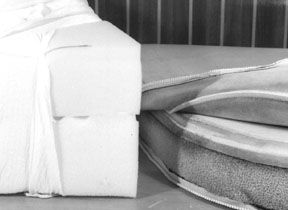
“Haven’t had a single one come back,” Humbert said. He conceded that unless you spend a lot of nights aboard or treasure a good night’s sleep, the expenditure is questionable.
At the low end, you might get a set of plain vanilla foam mattresses from Defender for as little as $900 (for 3-inch thick foam) to $1,200 (for 6-inch).
The Bottom Line
As is true of most other marine gear, boat mattresses, too, live in a difficult environment—much tougher than in a home on shore, where there’s less humidity, stable temperatures, and conditions less likely to encourage mold, mildew, or worse.
Quality is important in a mattress, not only for comfort, but for long-term serviceability. You can buy inner spring boat mattresses with a lifetime warranty, but we’re inclined to favor foam options. We’re not convinced that even powder-coated metal (in the springs) will endure in a marine environment. The foam, of course, must be high quality. And, we recommend the use of some form of moisture mitigation to protect the mattress.
Ultimately, the best advice on this topic came from DiMartino, of S&S Fabric, who told us: “You can, with a little effort, match the kind of sitting and sleeping comfort you choose to the number of dollars you want to spend.”
Also With This Article
“Moisture Mitigation”
Contacts
• Defender Industries, 800/628-8225, www.defender.com
• Handcraft Mattress, 800/241-7751, www.boatbeds.com
• Nauti-Pedic Mattress, 877/524-2437
• Palmer Bedding, 215/335-0400, www.boatmattress.com
• S&S Fabrics, 800/441-2252, www.ssfabricproducts.com
• Tempur-Marine, 800/482-6960, www.tempurmarine.com



























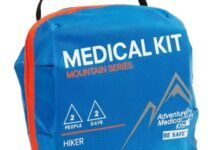





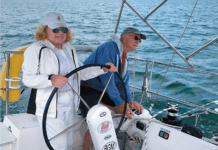






No mention of VOC’s and natural latex mattresses